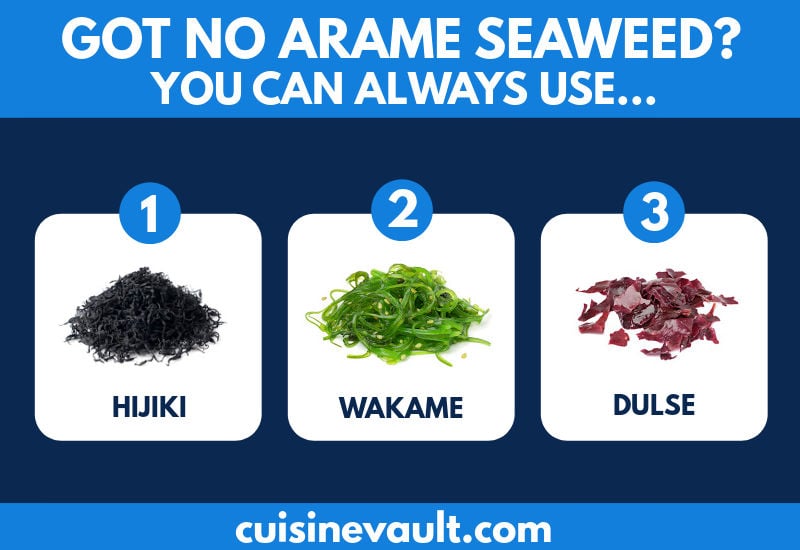Arame is a type of seaweed that is popular in Japanese cuisine. Its thick dark brown leaves, once processed, become thin wiry strands that look a lot like black vermicelli. Arame has a mild slightly sweet flavor with a texture that is firm. Its subtle taste makes it a versatile ingredient in many dishes including soups, casseroles, sauces, and salads. However, this seaweed is not a common ingredient in many supermarkets. If you can't get your hands on arame then you're going to need a suitable substitute. We've compiled a list of the best replacement options so that you can finish that recipe today. Let's dive in.
Table of Contents
The top 5 arame substitutes
1. Hijiki
Hijiki should be your go-to option for replacing arame. It is a dark brown or black seaweed which has a mushroom-like flavor and intense levels of rich umami. Hijiki is a less mild option than arame and is also a little less delicate. It is packed with minerals and fiber and is thought to have many nutritional benefits.
Although they are visually quite similar, hijiki is coarser and thicker than arame. Hijiki must be soaked and chopped before useing in the kitchen. Once you begin to cook, we recommend simmering it for 30-40 minutes. This will ensure the seaweed is deliciously tender.
If you are looking to replace arame with a subtle-flavored ingredient, then hijiki may not be the best option. It has a fishy flavor and is also quite salty, so it won't be ideal for some kids and those with sensitive taste buds. If you do decide to use it, then you can easily balance the saltiness with some additional ingredients such as bell pepper, tamari sauce, or ube.
2. Wakame
Wakame is also a type of edible seaweed and is classified as a sea vegetable. It has a unique flavor which is a powerful mix of salty, sweet, and umami flavor all rolled into one. This seaweed is often added to food raw; it is firsty rehydrated, then tossed into miso soup and added to salads.
The texture of wakame is noticeably different from arame. First, its color is a deep green rather than black. Also, it has a soft texture with no crunch. If you're going to use wakame in your cooking, we suggest including some additional crunchy ingredients like cucumber or shrimp.
3. Dulse
Dulse is an extremely popular edible seaweed in Japanese cookery. Its texture compares to fruit leather with a taste that is intensely savory. Dulse adds incredible depth of flavor to dishes and chefs revere this ingredient for its flavor and texture that is similar to bacon. Unlike most other seaweed types, dulse can be eaten raw, straight from the bag. It makes a delicious salty snack and can be used as a plant-based replacement for meat. It is delicious in sandwiches and can also be added to stews, paella, or used to enhance the flavors in seafood. You can read more about dulse in our article here.
While dulse is an excellent replacement for arame, it does have its differences. It lacks the sweetness of our arame and has a more intense salty flavor. But with a little creativity you can mimic the flavor offered by our arame by reducing the salt and adding some additional sweet ingredients.
4. Kombu
Kombu, also known as kelp, is sold in dried sheets and like most other options on this list will need to be dehydrated before use. If you're making a Japanese dashi, casserole, or broth, then kombu is an excellent replacement for arame. This kelp is packed with glutamic acids which are the building blocks of MSG; the resulting flavor is umami-rich and slightly briny without any fishy taste. Many people compare kombu to mushrooms in flavor.
5. Sea grapes
The umibudo, or sea grape, is a popular algae species, used in dishes in parts of Japan and Southeast Asia. They look a lot like small clusters of green grapes, so they won't replace arame visually in a dish. It has a salty flavor with a slightly sweet and acidic undertone.
Sea grape lovers will tell you that the best thing about this ingredient is the texture; the delicious balls contain tiny bubbles that pop in your mouth when eaten. Of course, this is quite different from arame, but if you're wanting something a little different then this is a great option. Sea grape can be used in many dishes such as sashimi rice bowls, sauces, and they make excellent garnishes.
 Fast facts
Fast facts
- The scientific name for arame is Eisenia bycyclis. It is a close cousin to hijiki.
- Arame is a healthy food that is loaded with calcium, iron, and iodine. It is believed to encourage soft and glossy hair as well as wrinkle-free skin.
- The plant loves to grow in cold water and as is commonly harvested on the East Coast of Japan, throughout the Ise Peninsula.
Summing up
Arame is a popular type of seaweed commonly used in kitchens throughout Japan. If you've come across recipes that call for this ingredient then the best options to replace it are hijiki, wakame, kombu, dulse, or sea grapes. None of them will perfectly mimic the flavor, texture, and color of the original ingredient but they certainly won't be out of place either. They will bring delicious salty, umami flavor that will add a depth of flavor to many dishes. Whichever option you choose, use similar quantities of the substitute for best results.
What is your favorite Japanese ingredient that you couldn't live without? Please let us know in the comments below and will be sure to check it out if we haven't already.

Leave a Reply